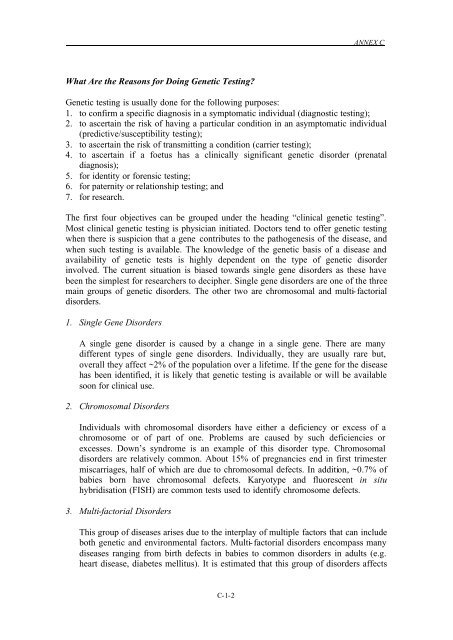Medical, ethical, legal and social issues in genetic - Bioethics ...
Medical, ethical, legal and social issues in genetic - Bioethics ...
Medical, ethical, legal and social issues in genetic - Bioethics ...
You also want an ePaper? Increase the reach of your titles
YUMPU automatically turns print PDFs into web optimized ePapers that Google loves.
What Are the Reasons for Do<strong>in</strong>g Genetic Test<strong>in</strong>g?<br />
C-1-2<br />
ANNEX C<br />
Genetic test<strong>in</strong>g is usually done for the follow<strong>in</strong>g purposes:<br />
1. to confirm a specific diagnosis <strong>in</strong> a symptomatic <strong>in</strong>dividual (diagnostic test<strong>in</strong>g);<br />
2. to ascerta<strong>in</strong> the risk of hav<strong>in</strong>g a particular condition <strong>in</strong> an asymptomatic <strong>in</strong>dividual<br />
(predictive/susceptibility test<strong>in</strong>g);<br />
3. to ascerta<strong>in</strong> the risk of transmitt<strong>in</strong>g a condition (carrier test<strong>in</strong>g);<br />
4. to ascerta<strong>in</strong> if a foetus has a cl<strong>in</strong>ically significant <strong>genetic</strong> disorder (prenatal<br />
diagnosis);<br />
5. for identity or forensic test<strong>in</strong>g;<br />
6. for paternity or relationship test<strong>in</strong>g; <strong>and</strong><br />
7. for research.<br />
The first four objectives can be grouped under the head<strong>in</strong>g “cl<strong>in</strong>ical <strong>genetic</strong> test<strong>in</strong>g”.<br />
Most cl<strong>in</strong>ical <strong>genetic</strong> test<strong>in</strong>g is physician <strong>in</strong>itiated. Doctors tend to offer <strong>genetic</strong> test<strong>in</strong>g<br />
when there is suspicion that a gene contributes to the pathogenesis of the disease, <strong>and</strong><br />
when such test<strong>in</strong>g is available. The knowledge of the <strong>genetic</strong> basis of a disease <strong>and</strong><br />
availability of <strong>genetic</strong> tests is highly dependent on the type of <strong>genetic</strong> disorder<br />
<strong>in</strong>volved. The current situation is biased towards s<strong>in</strong>gle gene disorders as these have<br />
been the simplest for researchers to decipher. S<strong>in</strong>gle gene disorders are one of the three<br />
ma<strong>in</strong> groups of <strong>genetic</strong> disorders. The other two are chromosomal <strong>and</strong> multi-factorial<br />
disorders.<br />
1. S<strong>in</strong>gle Gene Disorders<br />
A s<strong>in</strong>gle gene disorder is caused by a change <strong>in</strong> a s<strong>in</strong>gle gene. There are many<br />
different types of s<strong>in</strong>gle gene disorders. Individually, they are usually rare but,<br />
overall they affect ~2% of the population over a lifetime. If the gene for the disease<br />
has been identified, it is likely that <strong>genetic</strong> test<strong>in</strong>g is available or will be available<br />
soon for cl<strong>in</strong>ical use.<br />
2. Chromosomal Disorders<br />
Individuals with chromosomal disorders have either a deficiency or excess of a<br />
chromosome or of part of one. Problems are caused by such deficiencies or<br />
excesses. Down’s syndrome is an example of this disorder type. Chromosomal<br />
disorders are relatively common. About 15% of pregnancies end <strong>in</strong> first trimester<br />
miscarriages, half of which are due to chromosomal defects. In addition, ~0.7% of<br />
babies born have chromosomal defects. Karyotype <strong>and</strong> fluorescent <strong>in</strong> situ<br />
hybridisation (FISH) are common tests used to identify chromosome defects.<br />
3. Multi-factorial Disorders<br />
This group of diseases arises due to the <strong>in</strong>terplay of multiple factors that can <strong>in</strong>clude<br />
both <strong>genetic</strong> <strong>and</strong> environmental factors. Multi-factorial disorders encompass many<br />
diseases rang<strong>in</strong>g from birth defects <strong>in</strong> babies to common disorders <strong>in</strong> adults (e.g.<br />
heart disease, diabetes mellitus). It is estimated that this group of disorders affects


